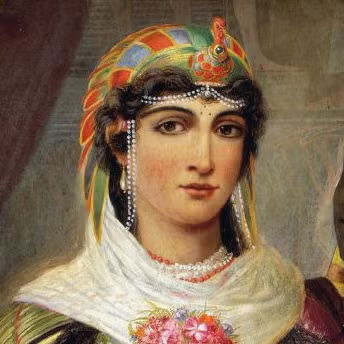
Table of Contents
Cleopatra VII: The Last Pharaoh of Egypt
Cleopatra VII, one of history’s most iconic rulers, belonged to the Macedonian dynasty that controlled Egypt from the late 4th century B.C. Her reign is remembered not only for her political acumen but also for her alliances and romances with powerful Roman figures like Julius Caesar and Mark Antony. Cleopatra’s life, filled with drama, intrigue, and ambition, has inspired numerous works of art, including William Shakespeare’s play Antony and Cleopatra and the famous 1963 film starring Elizabeth Taylor.
Early Life and Macedonian Heritage
Born around 69 B.C., Cleopatra VII Thea Philopator was the last ruler of the Macedonian dynasty, which had governed Egypt since 323 B.C., following the death of Alexander the Great. The dynasty was founded by Ptolemy I Soter, one of Alexander’s generals, who declared himself King of Egypt. Under Ptolemaic rule, Egypt grew into one of the most powerful kingdoms of the ancient world.
Cleopatra’s father, King Ptolemy XII, ruled before her. While little is definitively known about her mother, some speculate she may have been Cleopatra V Tryphaena, her father’s sister. There has been ongoing debate over Cleopatra’s ethnicity, with some suggesting she may have had partial African ancestry.
Ruler of Egypt
In 51 B.C., upon the death of her father, Cleopatra ascended to the throne at the age of 18, alongside her younger brother, the 10-year-old Ptolemy XIII, with whom she may have been married, in keeping with the dynasty’s tradition. The early years of her reign were tumultuous, marked by economic difficulties, including famine and floods, which weakened Egypt.
Cleopatra’s reign was also shaped by political struggles. Conflict arose between her and her brother, leading Cleopatra to flee to Syria, where she gathered an army to reclaim the throne. In 48 B.C., she returned to Egypt and faced Ptolemy XIII in battle at Pelusium, on the empire’s eastern frontier, in her bid to solidify her power as sole ruler of Egypt.
Cleopatra’s political astuteness and charisma, along with her strategic alliances, would go on to define her reign and cement her place in history.
Cleopatra and Caesar
During the Roman civil war between Julius Caesar and Pompey, the conflict spilled into Egypt. After Pompey sought refuge there, he was executed on the orders of Ptolemy XIII. Caesar pursued his rival to Egypt, where he met Cleopatra, the ambitious queen. They quickly became allies, and their relationship blossomed into a love affair. With Caesar’s military support, Cleopatra was able to overthrow her brother and secure her position as the sole ruler of Egypt. After defeating Ptolemy’s forces in the Battle of the Nile, Caesar restored Cleopatra to the throne.
Following these events, Cleopatra accompanied Caesar to Rome, where she remained until his assassination in 44 B.C. She then returned to Egypt.
Cleopatra and Mark Antony
In 41 B.C., Cleopatra was summoned by Marc Antony, a leader of the Second Triumvirate ruling Rome after Caesar’s assassination. Antony sought to question her loyalty to the Roman Empire. Cleopatra, known for her dramatic flair, made a grand entrance into the city of Tarsus, captivating Antony with her beauty and charm. This meeting sparked a passionate love affair.
Antony, embroiled in his own power struggles with Caesar’s heir, Gaius Octavius (later Emperor Caesar Augustus), saw Cleopatra as a valuable ally. Cleopatra, in turn, sought to regain Egypt’s former territories in exchange for her support. Together, they formed a formidable political and military partnership.
Defeat by Octavian
In 34 B.C., Antony and Cleopatra returned to Alexandria in triumph, with great public displays of power. However, tensions with Octavian escalated when Antony declared Cleopatra’s son, Caesarion, as Julius Caesar’s legitimate heir, challenging Octavian’s position. Octavian retaliated, accusing Antony of betraying Rome by transferring Roman territories to Cleopatra and plotting to make Alexandria the new capital of the empire.
The conflict culminated in the Battle of Actium in 31 B.C., a decisive naval battle off the coast of Greece. Antony and Cleopatra’s forces were defeated, forcing them to flee back to Egypt.
Death
Following their defeat, Antony, mistakenly believing Cleopatra had died, took his own life. Cleopatra, in despair, also committed suicide shortly after, allegedly by allowing an asp to bite her, although the true cause remains debated. She died on August 12, 30 B.C., and was buried alongside Antony in a still-undiscovered tomb. After her death, Egypt became a province of the Roman Empire.
Legacy
Cleopatra’s life has fascinated historians and the public for centuries. As one of the few powerful female rulers in a male-dominated world, she demonstrated political acumen, strategic intelligence, and the ability to maintain Egypt’s independence amid internal and external challenges. Her reign symbolizes strength and leadership in a time of turmoil.
Children
In 47 B.C., Cleopatra gave birth to Caesarion, whom she claimed was the son of Julius Caesar, though he never publicly acknowledged him. Later, with Mark Antony, Cleopatra had three more children: twins Alexander Helios and Cleopatra Selene, and another son, Ptolemy Philadelphus.
Cultural Impact
Cleopatra’s life, filled with political ambition, romance, and tragedy, has been retold in numerous dramatic adaptations. The most iconic film portrayal was the 1963 epic Cleopatra, starring Elizabeth Taylor. Earlier film versions include the 1917 silent film with Theda Bara and a 1934 production featuring Claudette Colbert. Cleopatra’s relationship with Mark Antony also inspired William Shakespeare’s Antony and Cleopatra, first performed in 1607, cementing her status as a legendary figure in literature and the arts.
